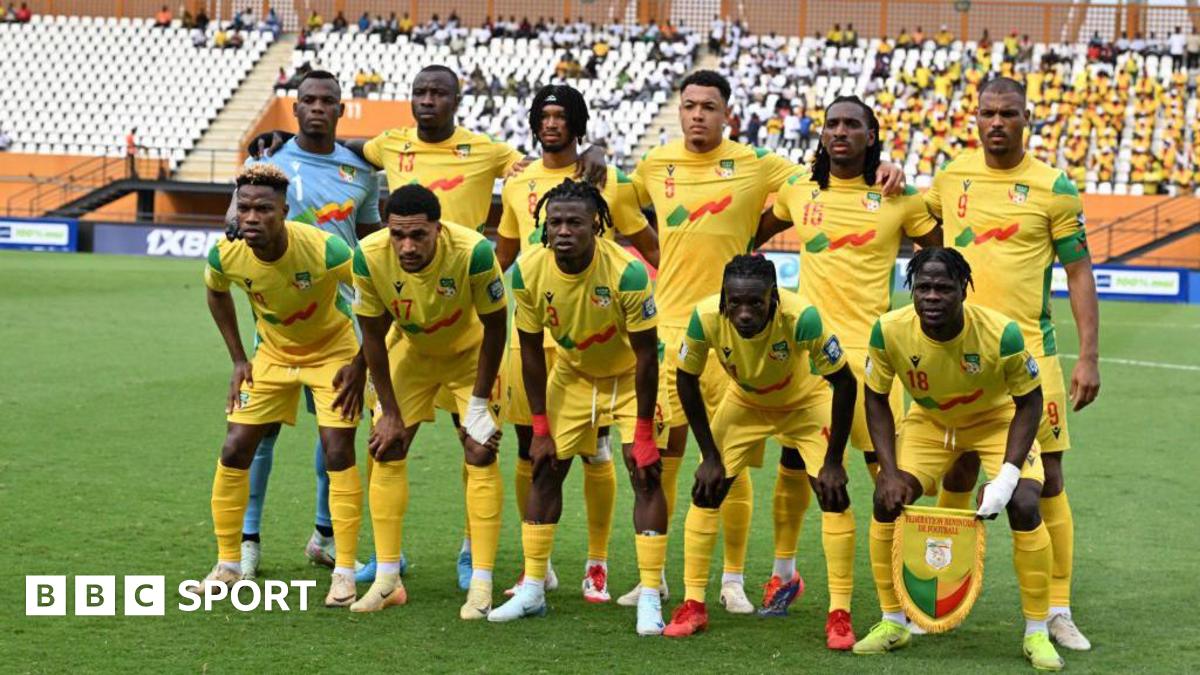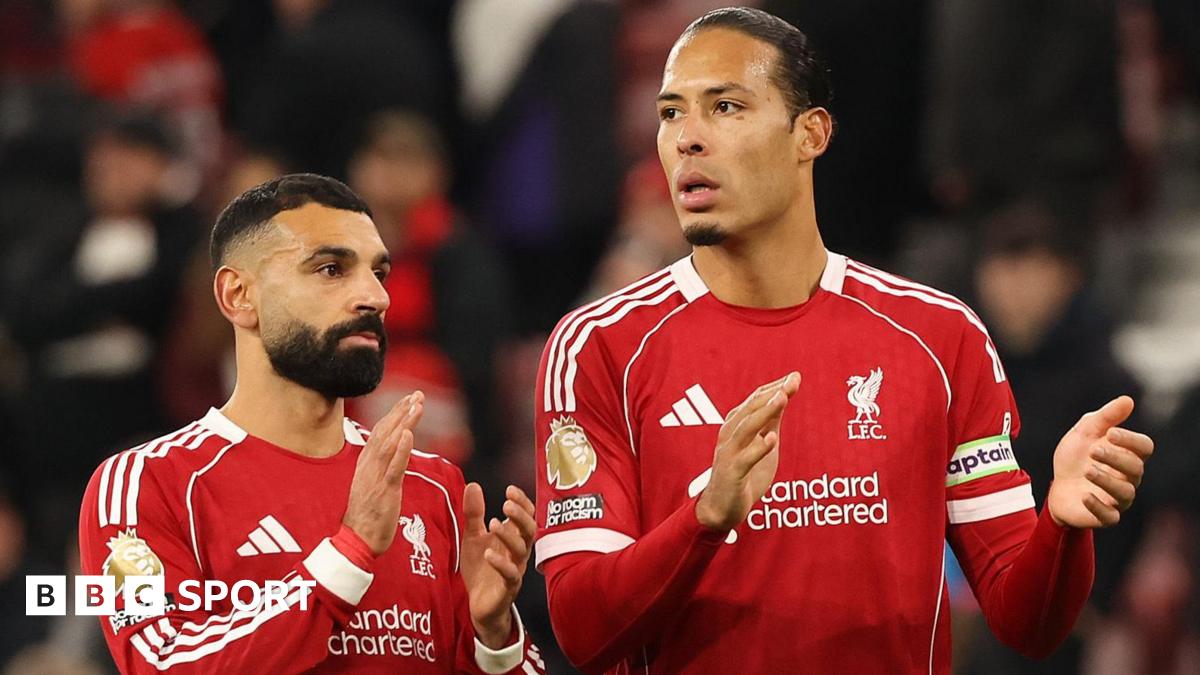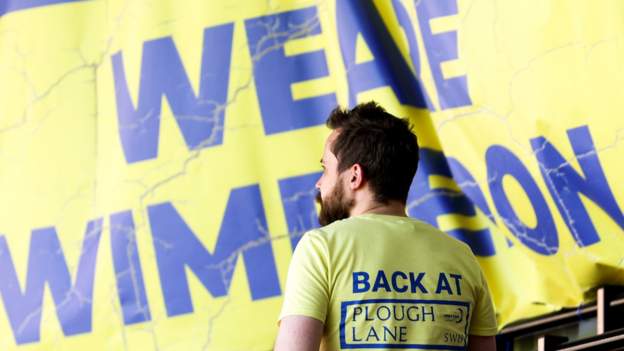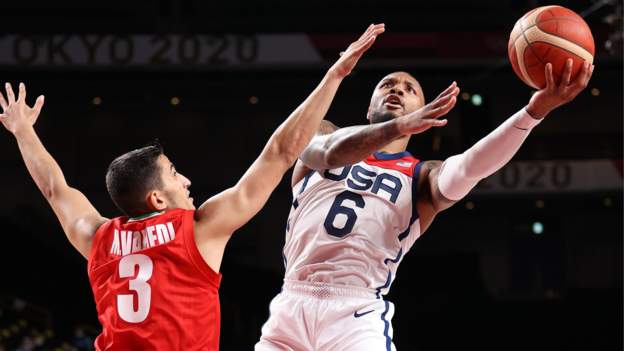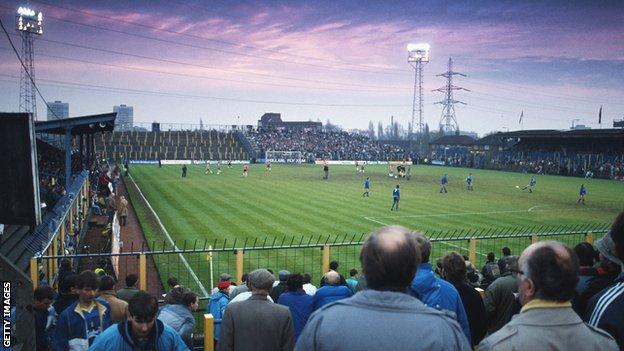
They like a good tale at AFC Wimbledon; their remarkable history is full of them. On Saturday there was another as Ollie Palmer scored the first FA Cup goal in front of fans on Plough Lane for more than 30 years.
Born in 1992, the year after Wimbledon left their old Plough Lane ground, Palmer was a childhood fan and went to matches at Selhurst Park. When in 2002 the Football Association gave consent for the club to move to Milton Keynes, he stopped supporting them, like many others.
As he calmly went round the Guiseley keeper to slide the ball home and send his side through to the FA Cup second round with a 1-0 victory on Saturday, there was a sense of job done in more ways than one.
The home fans in the 4,973 crowd enjoyed it, as did those who watched the game from the flats overlooking the new Plough Lane stadium, constructed as part of the deal that brought AFC Wimbledon ‘home’.
It won’t live in the memory as long as Lawrie Sanchez’s first-half header at Wembley in 1988, when Bobby Gould’s ‘Crazy Gang’ stunned Liverpool to win the FA Cup. But it does take them closer to earning another chance to upset English football, in the competition that helped forge their very identity – with a second-round home tie against Gillingham or Cheltenham to come next.
Certainly, with Wimbledon it would be unwise to rule anything out. If their rich history on Plough Lane shows us anything, it is that nothing is impossible for that club.

“People often ask: ‘When did the Wimbledon story really start?'” says Ivor Heller, AFC Wimbledon’s commercial director and a central figure in the club’s rise from the dead.
Heller points back to the team’s FA Cup run of 1974-75. Then in the Southern League, in the fifth tier of English football, Wimbledon beat Burnley at Turf Moor in round three, in one of the rare occasions a non-league team has beaten a top-flight opponent on their own ground.
For round four they went to Leeds – who would contest the European Cup final four months later – and drew, thanks to goalkeeper Dickie Guy – now AFC Wimbledon’s president – saving a Peter Lorimer penalty. Some 45,071 spectators were at Selhurst Park for the replay, which Leeds won 1-0 through a Dave Bassett own goal.
That cup run brought Wimbledon national attention in the days when clubs had to apply for election to the Football League. Under the system, abolished in 1986, league members had to vote one of their own out for the applying club to be successful. It didn’t happen often.
Wimbledon won the Southern League in 1975 and 1976 and applied for Football League membership in both years. They failed on each occasion.
But a combination of the positivity surrounding their FA Cup exploits and their location – easily accessible in south-west London – meant they were elected following a third successive Southern League title in 1977, as Cumbrians Workington were dumped, only the third club to be voted out since the establishment of the fourth division in 1958.
What followed was one of English football’s most remarkable rises. Nine years later, Wimbledon reached England’s top flight. Two years after that – in 1988 – they beat Liverpool at Wembley to win the FA Cup.
Evidently, the standard of player improved as they went up the leagues. But their stadium did not.

“Plough Lane was a shambles of a non-league stadium,” says Lawrie Sanchez, scorer not only of the goal that won the FA Cup in 1988 but also the winner at Huddersfield two years earlier that got Wimbledon promoted to the top flight.
“I can’t emphasise non-league enough. During all those promotions, the ground had virtually nothing spent on it,” he adds.
“The tunnel was no wider than six feet. There were one or two infamous incidents in there. The floor was concrete as well. We all had studs on so you had to be fairly nimble. Anyone running in or out of the tunnel was likely to end up on their backside.
“As for the dressing rooms, it was in the days of two substitutes, so there was just about enough room if the manager got changed somewhere else. At half-time, they used to keep the subs out so the manager and his assistant could talk.”
And if that was for the home side, what about their visitors?
“They were the worst you will ever see,” says Dennis Lowndes, a lifelong fan who used to work at the club on the ticketing side and is now part of the ground staff.
“We did everything to make it uncomfortable for them, including putting water on the floor. They used to moan and groan about that.
“My dad worked in the changing rooms. He was a Wolverhampton man and when they came in 1985 he told the manager, Tommy Docherty, it was the worst Wolves side he had ever seen. Docherty turned on him: ‘How can you play football in a place like this?'”
As Sanchez succinctly puts it: “The big teams just wanted to get out with the least amount of damage they could.”
Unlike the Wimbledon players.
“The room we used for meals before games we converted into a players’ bar afterwards, and then it turned into a nightclub in the evening,” adds Sanchez. “Many a player was chucked out of there at 2am.”
But not everyone embraced it.
In his programme notes for Wimbledon’s first top-flight home game, against Aston Villa on 26 August 1986, manager Dave Bassett condemned Football Association secretary Ted Croker for saying Wimbledon’s facilities were “totally incapable” of staging First Division football and that it was “ridiculous” clubs such as Manchester United and Tottenham were having to go there.
A year later, owner Sam Hammam used the match programme to reveal his intention to move out of Plough Lane, which he said was “a hindrance to our ambitious plans”.
Contentiously, he added it was “incapable” of being developed to the standard required.
Some still argue that statement was fundamentally wrong and that a 20,000 capacity stadium could have been built on the same site.
Hammam disagreed. And when the Taylor report into the Hillsborough tragedy was published in 1990 and recommended clubs move towards all-seater stadiums, plans to ground-share with Crystal Palace at Selhurst Park were put in motion.
“Plough Lane was only a noose round the neck of the owners because it suited them to sell the land,” says Heller.
“There weren’t really any arguments. It was all done in a way that didn’t give you a chance to argue.
“There had been a lot talk but no-one thought we would move out of Plough Lane and that would be it. But that is exactly what happened. There was no great fanfare. There was no great ‘this is the last game ever at Plough Lane’.
“It was the close season and it was just done. It all felt very underhand.”

Wimbledon played their last match at Plough Lane on 4 May 1991, coincidentally against Crystal Palace.
Selhurst Park was home for the next 11 years but when an FA arbitration hearing gave the club permission to relocate to Milton Keynes, a new club – AFC Wimbledon – was formed and attendances at the old one collapsed.
Playing at Kingsmeadow, now home to Chelsea’s women’s team, AFC Wimbledon averaged crowds of 3,003 in 2002-03, their first season in the Combined Counties League Premier Division – then in the ninth tier of English football.
In that same season, Wimbledon, soon to become Milton Keynes Dons, attracted 664 to Selhurst Park for a League Cup tie with Rotherham.

It’s only six miles from Plough Lane to Kingsmeadow but the people running AFC Wimbledon never wanted it to be a permanent home. They wanted to be back in Merton, where they could set down roots.
And in Merton Council leader Stephen Alambritis, they had a man who wanted to make it happen just as much as they did.
A Fulham fan brought up in the shadow of Craven Cottage, Alambritis instinctively thought the sight of fans going to stadiums and the floodlights shining on dark nights was “magical”.
“One of the first things I did as leader was apologise to the fans of AFC Wimbledon because the council did have a part to play in its demise,” he says. “We let go of a covenant that said this plot is only for sport, which meant Sam Hammam could sell the old stadium for housing.”
Alambritis met Heller and AFC Wimbledon chief executive Erik Samuelson. A bond was formed almost immediately.
“What I got from those two was a real consistency and continuity, that those were the two I was dealing with and they were the two who would come back,” he says.
“With something like this, councils can be floppy. I had to say these two guys will represent the football club. They are genuine and they are on the ball. It is a great story. We made a mistake years ago, let’s have them back.”
Alambritis got a sports intensification usage stipulation put on Wimbledon Greyhound Stadium, 250 yards further along Plough Lane from where Wimbledon used to play. With greyhound racing on the decline, Alambritis went to the company that had lent money to the stadium’s owner and put together a deal involving the council, AFC Wimbledon and property company Galliards.
“I like making things happen and what do people remember? Things that stick out of the ground,” he said. “I had a vision that things would happen with me as leader, that people would go past somewhere and say ‘there is a football stadium that wasn’t there before’.”
In addition to the stadium, which can be expanded from its current 9,125 capacity to 20,000 if the demand warrants it, there were 850 housing units “32% of which are affordable”, says Alambritis.
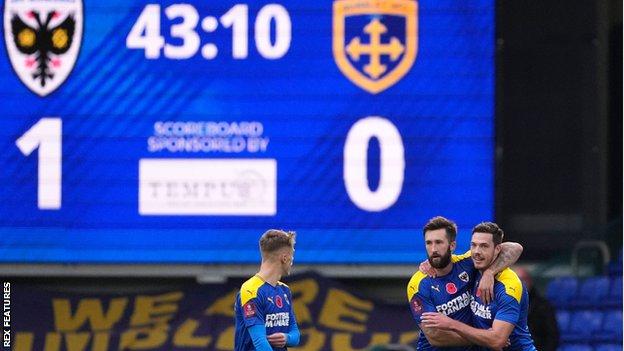
He didn’t get everything he wanted – AFC Wimbledon’s postcode is SW17, which belongs to Wandsworth – and the Post Office rejected Alambritis’ request to change it to SW19, which is Merton and what the old ground was.
But, essentially, Wimbledon were back. All they needed was the money to build the ground. A vast revenue generating exercise was undertaken and when author and fan John Green gave the final push with his own sizeable donation, the building work began. On 3 November 2020, the club returned to Plough Lane for a League One encounter with Doncaster. Sadly, no fans were there to see it.
“In one sense it was great but playing in the ground with no fans was soul-destroying,” says Heller.
“It was horrendous. You are there with a load of ghosts. You started not to be able to imagine what it was going to be like with people in it.”
Heller got his wish at the start of the current League One campaign, when Bolton were the visitors on the opening day for an amazing 3-3 draw as AFC Wimbledon came back from 3-1 down.
The new stadium does not have the old hot dog and onion smell Heller remembers from his youth, watching football at the old one in the 1970s. Neither does the strong waft of liniment come out of the changing rooms if you happen to be standing close enough.
But, sited just over the other side of the River Wandle and the massive electricity pylon that figures in so many pictures of the old ground, it does have rail seats, as befits a modern stadium. Space is maximised – the site itself is probably no bigger than the old one, and there is cover for spectators on all four sides, which the old Plough Lane did not have.
It also has some appropriate banners proclaiming: ‘The Dons are back’, ‘We are the resurrection’, ‘There is a light that never goes out’ and ‘Keep the faith’.
And, while some monetary issues are still to be resolved given a bridging loan was part of the initial funding, those running the club are embracing having to deal with everyday football queries – on Saturday that included a perceived negative style of play – rather than existential ones.
Who knows where the journey will take them.
“After what we have been through, who wants to tell me what I can dream and what I can’t? Who wants to put a glass ceiling on us?
“We are starting from a much bigger base than when we came into the league in 1977, I can tell you that.”


